Korean Melon: A Refreshing Slice of Korean Culture
Have you ever seen a melon that looks like sunshine? That’s the Korean melon.
This isn’t your average grocery store find. We’re talking about a melon that’s as beautiful as it is delicious, boasting a sunshine-yellow rind and a flavor that will have your taste buds doing a happy dance.
But Korean melons are more than just a pretty face (or rind). They’re exploding in popularity among home gardeners for a reason: they’re surprisingly easy to grow!
Curious? Buckle up, because we’re going to explore everything about Korean melons.
From their fascinating history to the nitty-gritty of growing your own, this guide will have you cultivating a little piece of Korean summer right in your own backyard.
Jump to a section:
What is a Korean Melon?
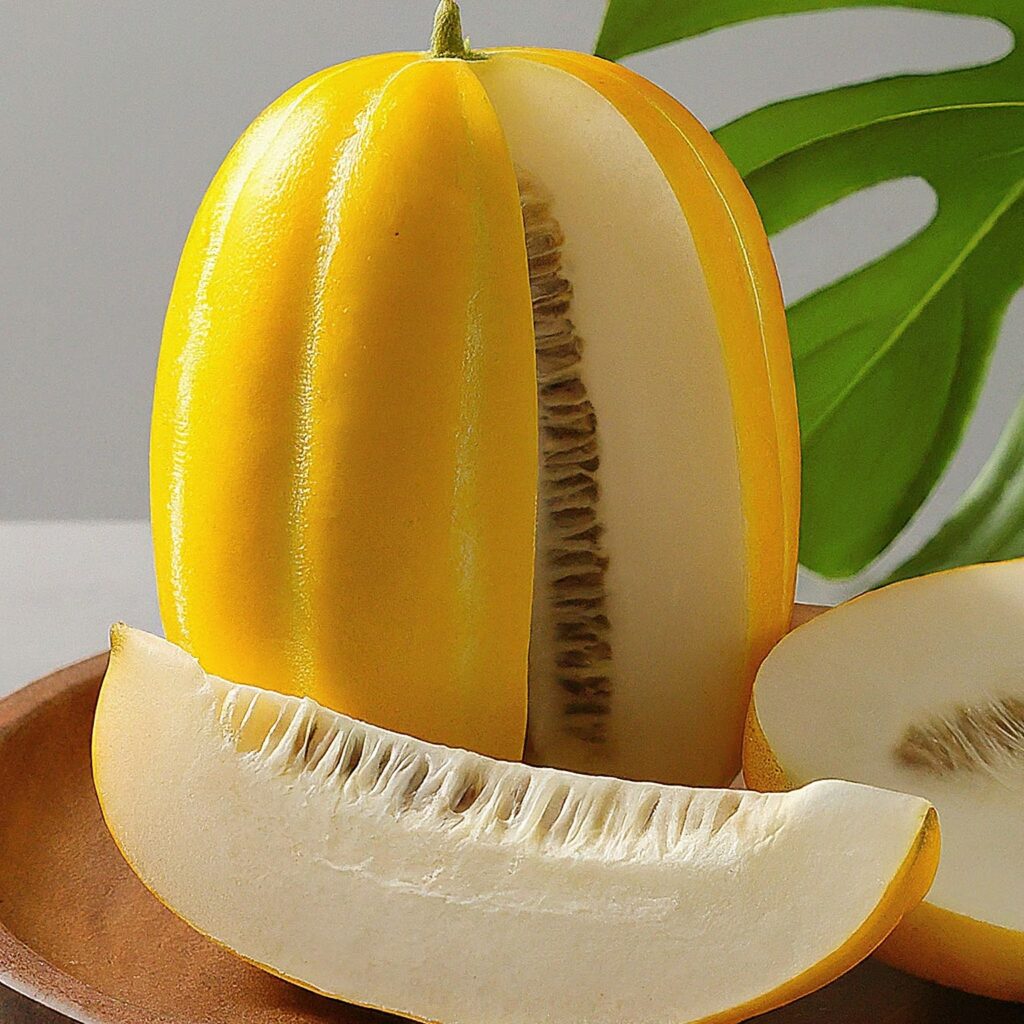
But first things first, what is a Korean Melon?
Korean melons (Cucumis melo L.), are close relatives of cantaloupes and honeydew. Their smooth rind, typically light yellow or cream-colored with green netting, can sometimes have variations depending on the variety.
Inside, you’ll find juicy, pale green or white flesh that’s incredibly sweet and has a distinct aroma. These melons come in various sizes, ranging from baseball-sized to even larger than a cantaloupe!
History of Korean Melon
Korean melons have a history as rich and vibrant as their sunshine-yellow rinds.
Experts believe these tasty treats were introduced to Korea sometime between the 14th and 17th centuries, most likely taking a thrilling journey along the Silk Road from Central Asia.
Imagine those adventurous melon seeds hitching a ride on caravans, carrying the promise of summer sweetness all the way to the Korean peninsula!
Fast forward to the 19th and 20th centuries, and Korean melons became superstars. Cultivation skyrocketed, and their consumption became deeply ingrained in Korean culture.
They weren’t just a delicious summer snack but also a symbol of the season itself. When you see the markets overflowing with these golden globes, it is a sure sign that summer’s warm embrace has arrived.
But Korean melons aren’t just eaten, they are celebrated even to this day! Special festivals are organized in their honor, and competitions are held to find the most perfect specimens.
Even today, gifting a Korean melon is a way to show appreciation and spread some summer cheer. It’s a tradition that perfectly captures the special place this fruit holds in Korean hearts.
So, the next time you bite into a Korean melon, remember – you’re not just enjoying a tasty treat, you’re experiencing a taste of Korean history and culture!
Benefits of Eating Korean Melon
Korean melons aren’t just a feast for the eyes with their sunshine-yellow rinds. These beauties are bursting with benefits that’ll have you saying “Seoul good!” from the inside out.
Here’s why you should add them to your summer shopping list:
1. Hydration Hero: Picture yourself on a scorching summer day. Feeling parched? Korean melons come to the rescue! Packed with water, they’re a natural way to rehydrate and keep your body cool, like having a built-in internal water cooler.
No more lugging around heavy water bottles – just slice open a Korean melon and let the juicy goodness do its magic.
2. Sweetness with a Punch: Forget sugary drinks and artificial sweeteners. Korean melons are nature’s candy, exploding with sweetness that’ll satisfy your cravings without the guilt trip.
Plus, they’re a good source of natural sugars, giving you a quick energy boost without the crash.
3. Glowing Skin, Naturally: Who needs expensive serums when you have Korean melons? They’re loaded with Vitamin C, a superstar for promoting collagen production, which keeps your skin looking plump and youthful.
Think of it as a built-in summer skincare routine – just eat your way to a radiant glow!
4. Digestive Dance Party: Feeling sluggish after a heavy meal? Korean melons are high in fiber, which gets your digestive system doing the happy dance.
It helps keep things moving smoothly and prevents constipation, so you can say goodbye to bloating and hello to a happy gut.
5. Immunity Booster: Korean melons aren’t just delicious, they’re little warriors for your immune system. They come packed with Vitamin C and antioxidants, which fight off free radicals and keep you healthy all summer long.
6. A Seed of Health: Don’t toss those Korean melon seeds! Why? They’re a hidden treasure trove of nutrients. Packed with healthy fats and protein, those seeds a great way to add a little extra something to your diet.
Sprinkle them on salads, yogurt parfaits, or even bake them for a crunchy and healthy snack.
Korean Melon Varieties
The world of Korean melons is a kaleidoscope of color, sweetness, and texture. While they all share that signature Korean melon charm, each variety offers its own unique melody to the taste bud orchestra.
Here are a few popular players to get you acquainted:
1. Korean Honey Melon or Hwanggeummo (황금모) Melon
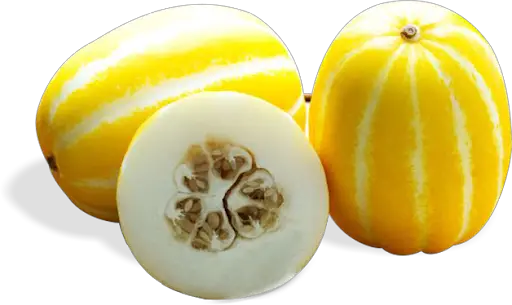
True to its name, which translates to “golden melon,” the Hwanggeummo is a stunner. Think of a melon bathed in sunshine, boasting a vibrant yellow rind that practically glows.
Crack it open and you’ll be greeted by flesh that’s not just incredibly sweet, but also boasts a luxuriously smooth texture. This variety is a true crowd-pleaser, perfect for those who crave pure, unadulterated sweetness.
2. Mosmelon (Muskmelon)
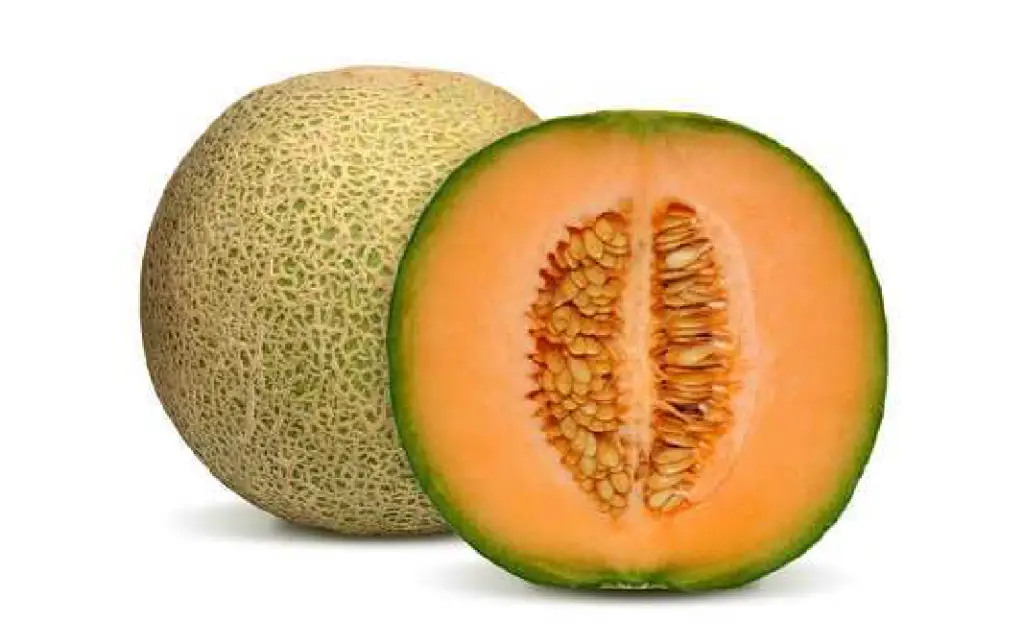
Don’t be fooled by its demure cream-colored rind with green netting – the Mosmelon packs a fragrant punch! This variety is all about the aroma. As you near it, a wave of sweetness tickles your nose, hinting at the deliciousness within. The flesh itself is a delightful balance of sweetness and a subtle muskiness, making it a favorite for those who appreciate a more complex flavor profile.
3. Korean Yellow Chamoe (참외)
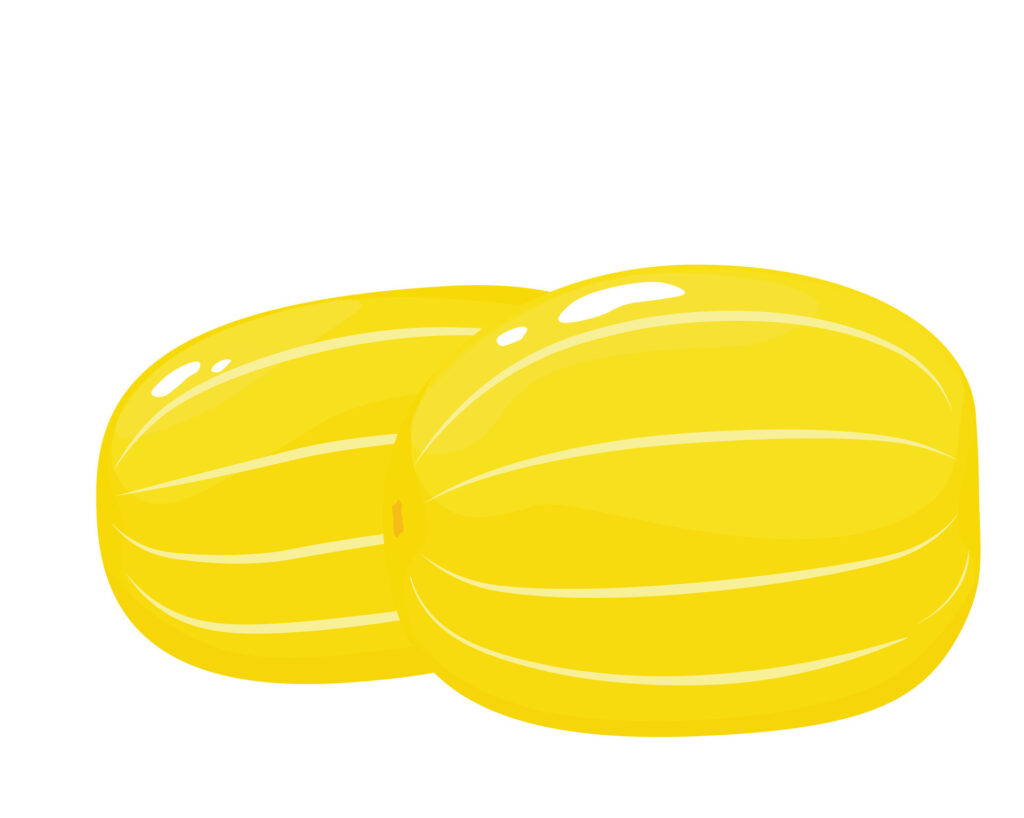
This aptly named melon (Chamoe translates to “melon” in Korean) is a vision of sunshine yellow.
Unlike its Hwanggeummo cousin, the Chamoe boasts a smooth, unnetted rind. Inside lies a treasure trove of juicy, crisp flesh that’s bursting with sweetness. The Chamoe is a favorite for those who enjoy a refreshing burst of flavor with a satisfying crunch.
With so many varieties to choose from, there’s a perfect Korean melon out there waiting to tantalize your taste buds!
How to Grow Korean Melon in Your Home Garden
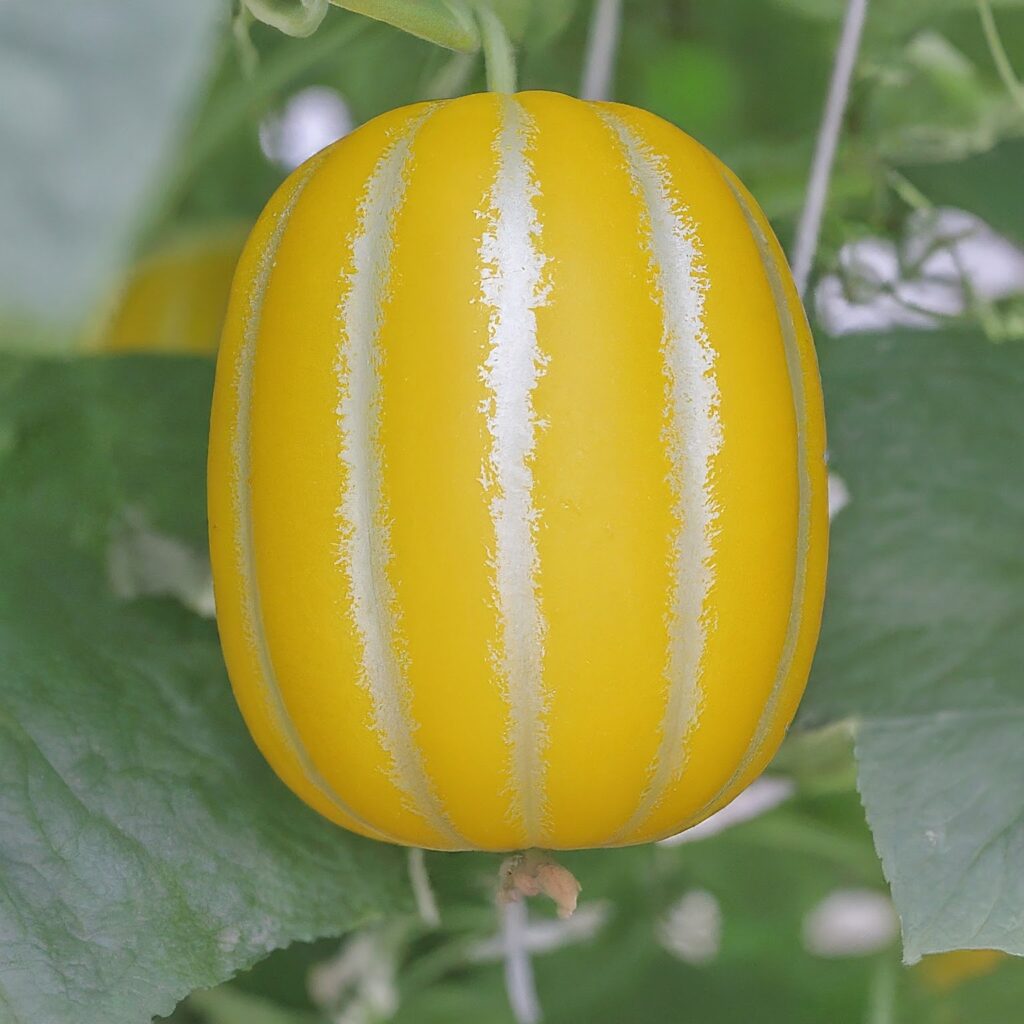
Thinking of bringing a taste of Korea to your garden? Korean melons are warm-season crops that thrive in full sun and hot temperatures.
Here’s a quick guide to get you started:
Climate and Planting Requirements
Korean melons are true sun worshippers. They thrive in full sun with warm daytime temperatures ideally between 70-85°F (21-29°C). Nighttime temperatures shouldn’t dip below 55°F (13°C). Remember, they’re frost-sensitive, so wait until all danger of frost has passed before planting outdoors.
Soil Preparation
The foundation for happy melons is well-drained, fertile soil.
A slightly acidic soil pH level, between 6.0 and 6.8, is the way to go. Also, don’t forget to amend your soil with plenty of compost or aged manure 4-6 weeks before planting. This will give your melons the nutrients they crave to thrive.
Planting Process
1. Direct Seeding
For the adventurous gardener, you can sow Korean melon seeds directly outdoors once the soil temperature reaches a consistent 70°F (21°C).
Sow seeds 1 inch deep and 3-4 inches apart in rows that are 5-6 feet apart. Thin seedlings to the strongest plant every 12 inches once they have a few true leaves.
2. Starting Indoors
Want to give your melons a head start? Sow seeds indoors 4-6 weeks ahead of your last frost date. Then plant seeds in individual pots filled with a well-draining potting mix. Make sure to keep them moist and provide plenty of warmth with a heat mat or sunny windowsill.
Once the seedlings have 4-5 true leaves and the outdoor temperature is right, harden them off for a week before transplanting them to your garden bed. Space them the same way you would for directly sown seeds.
Care and Maintenance
- Watering: Consistent moisture is key, especially during hot weather. Ideally, you should water deeply at the base of the plant 2-3 times a week, allowing the soil to dry slightly between waterings.
- Weeding and Mulching: Regularly remove weeds that compete with your melons for water and nutrients. Plus, apply a layer of organic mulch around the base of the plants to retain moisture, suppress weeds, and regulate soil temperature.
- Trellising: Korean melon vines are vigorous growers that benefit from vertical support. It is a good idea to install a trellis or sturdy cage before transplanting your seedlings. This encourages upward growth, improves air circulation around the fruit, and makes harvesting easier.
- Pollination: The good news is that Korean melons are open-pollinated, meaning they don’t require any special intervention to set fruit. Bees and other pollinators will naturally take care of the job, so you can sit back and watch your melons develop!
Harvesting and Enjoying Your Korean Melons
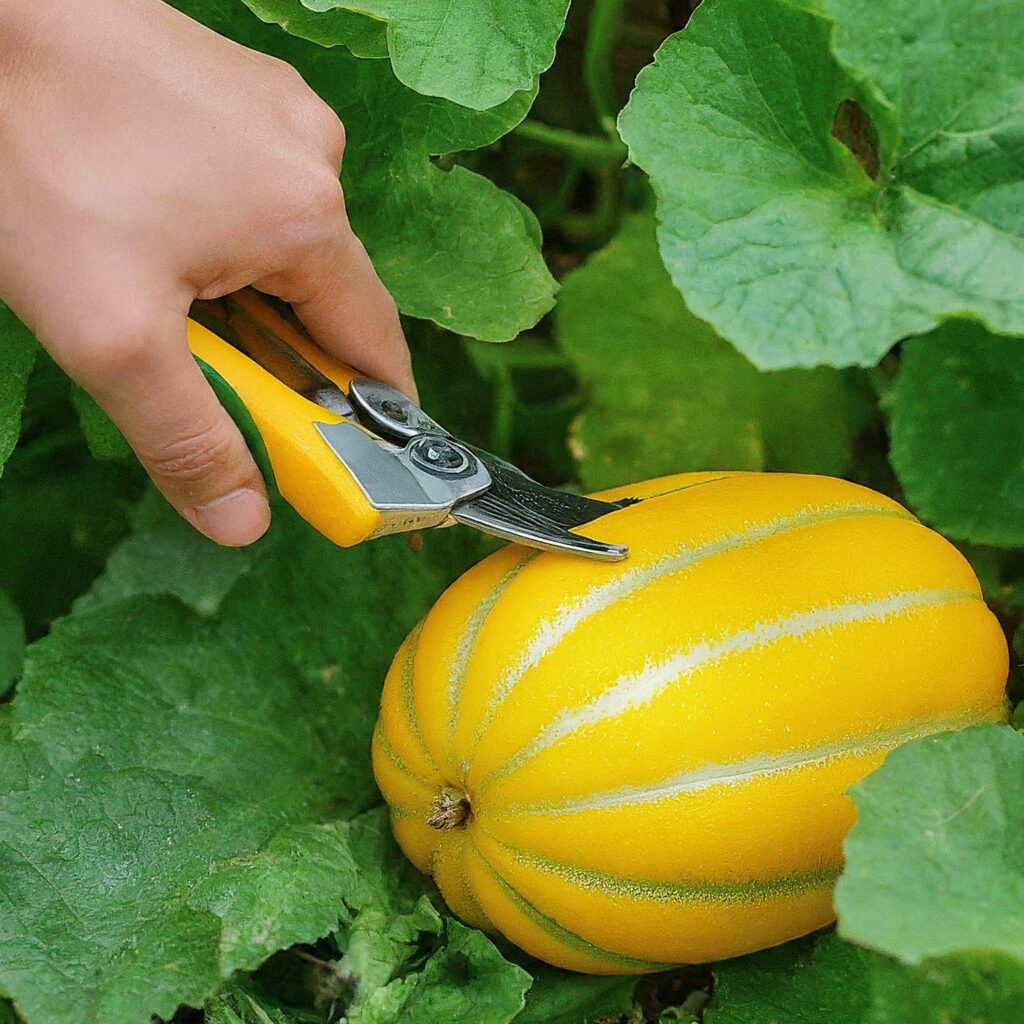
The moment of truth has arrived! Your Korean melons are nearing maturity, and it’s time to harvest the fruits of your labor. Here’s how to ensure you pick them at their peak ripeness and enjoy them to the fullest:
Ripeness Signs
- Visual Clues: Keep a close eye on your melons as they develop. A key indicator of ripeness is a change in the rind color. Depending on the variety, the once vibrant yellow rind might develop a slight creaminess or develop a subtle webbing of brown speckles.
- The Gentle Touch: Give your melons a gentle squeeze near the blossom end (the opposite end from the stem). If it yields slightly to firm pressure, that’s a good sign it’s ready to be picked. A completely hard melon isn’t quite there yet, while one that feels mushy is past its prime.
- The Aromatic Whisper: Ripe Korean melons announce their arrival with a delightful fragrance. As you near a ripe melon, you should be able to detect a sweet, honeyed aroma that intensifies the closer you get.
Harvesting Your Korean Melons
Once you’ve confirmed your melons are ripe, it’s time to harvest! Grab some sharp pruners or shears and carefully cut the melon from the vine. Leave a short stem attached to help prevent spoilage.
Storage and Consumption
Korean melons are best enjoyed fresh when their flavor and texture are at their peak. You can store them in a cool, dry place (not the refrigerator) for up to a week.
Once cut, however, Korean melons are best enjoyed within a day or two. The flesh can be wrapped tightly in plastic wrap and stored in the refrigerator to help maintain its freshness.
But the beauty of Korean melons lies in their versatility.
Here are some delicious ways to enjoy them:
- Fresh and Simple: Slice your melon into wedges or cubes for a refreshing summer snack. They’re perfect on their own or tossed into a fruit salad for a vibrant and flavorful mix.
- Salad Sensation: The sweetness of Korean melon pairs beautifully with savory ingredients. Try adding diced melons to a green salad with feta cheese, mint, and a drizzle of olive oil for a delightful summer lunch.
- Smoothie Sunshine: Blend your Korean melon with yogurt, milk, and a touch of honey for a cool and refreshing smoothie. Get creative and add other fruits like bananas or berries for a flavor explosion!
- Korean Melon Milk Dreams: Craving a taste of Korea? Simply blend some cubed melon with chilled milk and a touch of honey for a creamy and refreshing beverage.
- Beyond the Flesh: Don’t discard the melon rind! In Korea, they are sometimes pickled for a tangy and refreshing side dish.
Here’s a video about how to eat Korean melon:
So there you have it!
With a little patience and these handy tips, you’ll be harvesting and enjoying your own Korean melons in no time. Get ready to experience a taste of sunshine and celebrate the bounty of your summer garden!
Fun Facts About Korean Melons
Did you know that Korean melons are more than just delicious? Here are some interesting tidbits:
- They have a high water content, making them a perfect way to stay hydrated in the summer heat.
- They’re a good source of Vitamin C and potassium.
- In Korea, there are festivals and competitions dedicated to these beloved melons!
Conclusion
Korean melons offer a unique taste and cultural experience. They’re not only delicious and easy to grow but also a beautiful addition to any garden.
So why not try your hand at cultivating a taste of Korean summer in your home garden this year? You might be surprised at how easy and rewarding it is!
Korean Melon FAQs
What does Korean melon taste like?
Korean melon flavor is a delightful blend of cantaloupe, pear, and banana with a subtle floral note. Some people even detect a hint of cucumber or honeydew.
Are Korean melons healthy?
Yes! Korean melons are a good source of Vitamin C and potassium, and their high water content keeps you hydrated.
Do you eat the seeds in Korean melon?
Absolutely! The seeds and the surrounding pulp are considered to be the sweetest part of the melon.
What is another name for Korean melon?
Korean melon can also be called Oriental melon, Sun Jewel, Golden melon, or Japanese Cantaloupe.
How to tell if Korean melon is ripe?
A ripe Korean melon will have a slight color change on the rind, a gentle give when pressed near the stem, and a more noticeable aroma.
Is Korean melon a fruit or vegetable?
Korean melon is botanically classified as a fruit.

